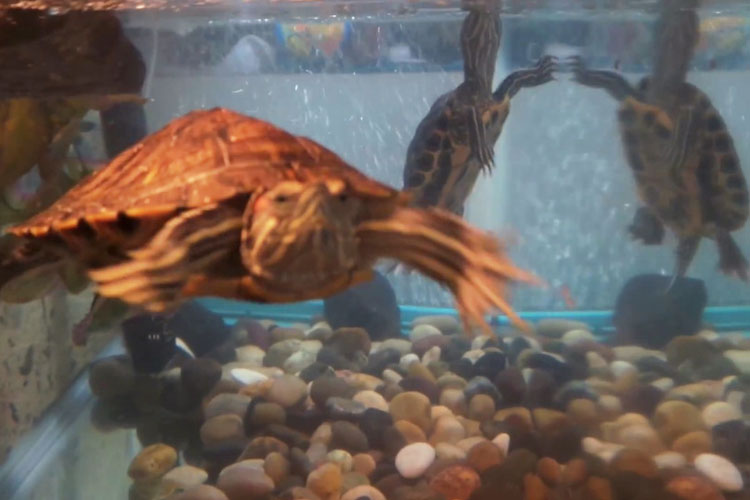Why Is My Turtle Tank Cloudy And How To Clear It?
So you have done your turtle’s tank water change, cleaned your filters, and did everything else right. But there’s a problem; your turtle tank looks cloudy. You start asking yourself what you did wrong and if there is a way to fix it.
Why is my turtle tank cloudy? Your turtle tank is cloudy because the water chemistry inside your tank is not balanced. This results in excess bacteria in the water which then create a cloudy appearance.
In the following guide, we have discussed more details on how this cloudy appearance forms in your turtle tank. We have also tackled related questions like how to fix the clear it, and how to prevent it from happening in the first place.
Why is my turtle tank cloudy?
Contents
Your turtle tank is cloudy because of the unbalanced water inside the tank. This can happen for water that isn’t new in the tank but turns cloudy with time. Or it can happen when you do a water change and the fresh water turns cloudy.
Turtles are also generally messy creatures, so there could be many reasons behind the cloudy turtle tank.
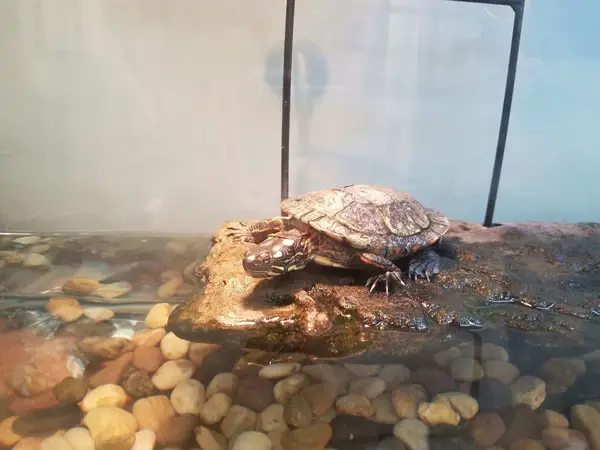
While most believe that the perfect fix for this issue is to replace the existing water, this isn’t always the case. Taking this direction may hinder the water quality instead of helping solve the issue.
Let’s discuss the main causes of a cloudy water tank:
Excess bacteria in the tank
The presence of excess bacteria is one of the main reasons behind your turtle tank getting cloudy. This is highly likely the cause of a tank that was set up recently, within the past 1-2 weeks.
When it comes to setting up turtle tanks, we try recreating a small piece of nature inside there to help keep things as natural as possible.
Wild turtles’ waste gets broken down by millions of beneficial bacteria. These simply break down the ammonia in the waste into less harmful nitrite before finally converting it into nitrate.
This entire process is referred to as the nitrogen cycle. The nitrogen is then absorbed by plants and gets filtered from the water.
For a turtle in captivity, a nitrogen cycle is also required to convert your pet’s waste from ammonia to nitrates. You then get rid of the nitrates via water changes or by introducing live plants into the tank to use the nutrients.
Now, when you have a newly setup fish tank, the good bacteria may not have had enough time to colonize or begin the reproduction process.
Thus, after a few days when your turtle produces waste, the bacteria start reproducing and hit a sustainable number to help convert the waste into nitrates.
This results in a huge bloom of bacteria that appears in the form of cloudiness in the turtle tank.
In simpler words, cloudiness is the beneficial bacteria attempting to break down your pet’s waste inside the water.
Your tank filter is unclean
If you don’t clean your tank filter regularly (or never clean it at all), it could be the culprit behind the cloudiness in your tank.
Uncleaned filters may cause an accumulation of waste and other organic material This will then sit in your tank filter and rot—causing algae growth, foul odor, and cloudy turtle tank water!
The filter may be forced to push out the waste it’s supposed to contain when it gets overrun with the amount of waste it’s supposed to handle. The result of this is a discolored water problem in your tank.
That said, we recommend cleaning your tank filter biweekly or monthly. if you follow this maintenance schedule and still experience cloudy water, consider increasing the cleaning frequency.
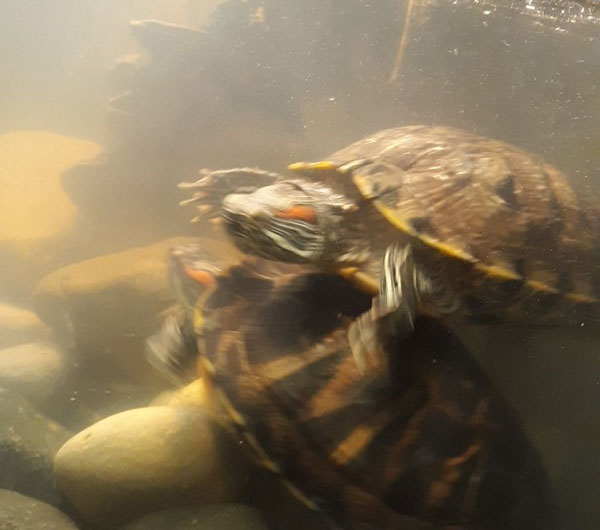
Not cleaning your filter correctly can also cause the problem. The bacteria responsible for a smooth nitrogen cycle process are housed inside your filter. Taking out the media housed inside the filter that helps with the production of this good bacteria and washing it in tap water could easily kill them ad wash them away.
Remember, your turtle tank has worked so hard to build this bacteria colony, and interfering with it simply means restarting the nitrogen cycle.
A new bacteria colony will be reproduced, and a bloom that comes as a result of it will make your tank water look cloudy.
Poor tank sanitation
A poorly maintained tank could be another reason you’re faced with a cloudy appearance in your turtle tank. If you have set up your tank for a long period of time and you start seeing cloudiness forming, this could be the most probable reason.
As you may already know, aquatic turtles can get very messy, not just when eating but also by producing huge amounts of waste. Thus, feeding your turtle friends inside the water risks creating a total mess.
This, in turn, creates bits of food in the form of particulate matter floating around the tank. These messy foods can easily form cloudiness around your tank. Moreover, it can result in an unpleasant odor and cause the water to form a film at the surface.
When this happens, the water quality quickly deteriorates. In this case, you should act fast to clean up your tank since the waste can easily irritate your pet’s eyes and cause health issues.
Why does my new turtle tank get cloudy?
Sometimes your new tank can become cloudy shortly after. The reason behind this is something known as New Tank Syndrome (NTS).
A newly setup tank in this case doesn’t necessarily mean a brand new one. It could also refer to a tank whose water has just been changed.
During this stage, your turtle tank’s biochemical properties are yet to be established and things are not balanced, hence the cloudy turtle tank water.
The good news, however, is that this cloudiness resolves on its own in such situations.
Your tank will need to undergo a chemical process and bacterial colonization, cycles that make it becomes “established” and balanced.
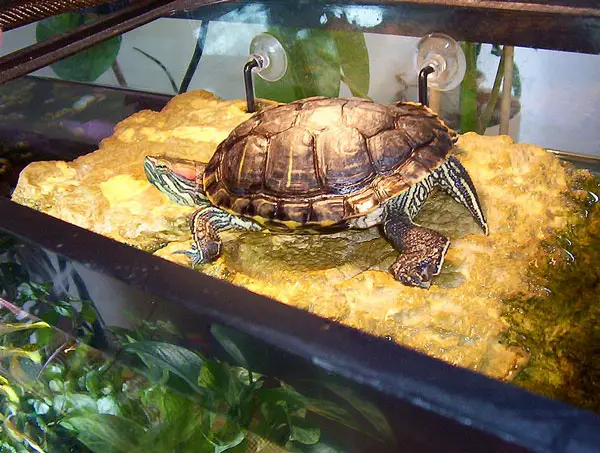
Once the turtle tank becomes balanced, it will contain the ideal number of good bacteria for breaking down waste into safe nitrate products. The nitrate will then be removed when you do a water change or when its levels get too high (you can check the levels using a water quality test kit).
When you’re faced with a cloudy situation for your new task, we advise against trying to change the water. Doing so will not help much; it will only restart the cycle or interrupt the tank established process. And you can be assured that cloudiness will show up again in a matter of days.
Just be patient and let the issue resolve on its own. This can take a few days to a week or two, during which the bacteria take time to establish themselves.
Once the water clears up, be sure to do future filter cleanups and water changes on time. This will ensure things remain clear and significantly minimize the cloudy situation.
Why is my turtle tank cloudy after the water change?
If your tank has gotten cloudy after a water change, this is simply a “new tank syndrome” and will resolve on its own after a couple of days. Sometimes it goes for a week or two.
Remember, a new tank doesn’t necessarily mean a brand new tank.
Any time you do a water change, you’ll also be making a new tank setup. And in so doing, you’ll be removing the good bacteria from your tank.
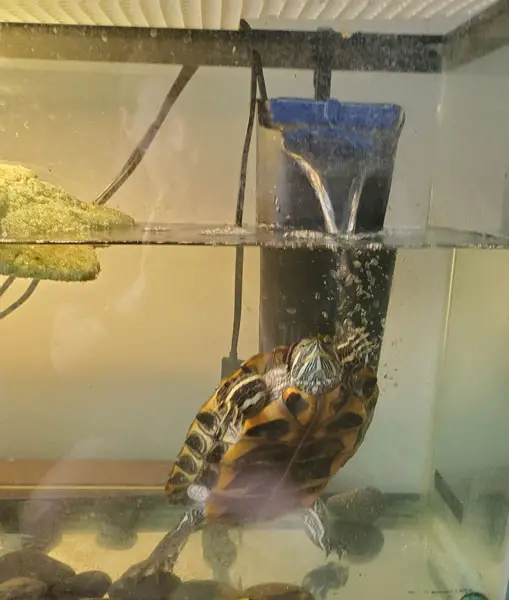
After you put new aquarium water, the beneficial bacteria will need to establish themselves again (as explained in our previous section) and make things balanced in your tank.
Just be patient and let the situation resolve on its own.
How to clear up a cloudy turtle tank?
When you have a cloudy situation in your tank, you’ll be asking yourself the most effective way to fix it and get your water back to normal.
The good thing is that the problem can go away on its own, depending on what’s behind it. But if it doesn’t, there are other methods you can employ to make the water crystal clear.
Here are the top fixes for cloudy turtle tank water:
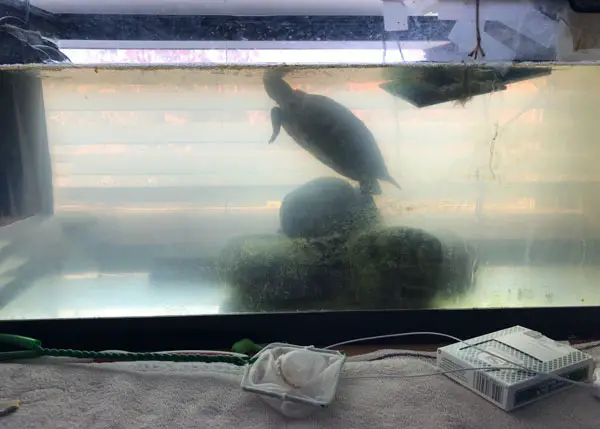
Give the “cloudiness” time to fix itself
If you just set up your tank recently and you’re convinced that a bacterial bloom is behind the cloudiness, the best way to fix is patience!
Leaver the tank to establish, and in a matter of days or weeks, the cloudiness will resolve on its own.
In other words, you’ll be giving the good bacteria time to establish and build up inside your tank. patience is key as it helps give the bacteria time to grow and start consuming the waste produced by your turtle.
This is essentially the “New Tank Syndrome”, during which the biochemical properties of your tank aren’t yet established. Giving it time to establish itself will get your tank balanced and eliminate cloudiness on its own.
Keep your filter clean
You should also clean your filter weekly or biweekly. However, sometimes you don’t have to go by this rule of thumb. Clean the filter anytime you notice its media is filled with waste and debris.
The filter is a crucial part of your turtle terrarium in that they help catch any material floating in the water to help keep the water clear and keep away the cloudy problem.
Filters also assist in the biochemical process that involves breaking down the animal waste into less harmful products.
That said, it is still important to manually get rid of the waste and debris building up inside the tank to further decrease the chances of cloudiness and keep the water clean.
Feed your turtle outside the tank
As we mentioned earlier, aquatic turtles are messy eaters. Feeding them inside leaves a mess in form of uneaten food inside the tank. These affect the water quality and form cloudiness and dirty water.
This can not only be unsightly and foul-smelling but can also encourage the growth of fungi that can cause various infections to your turtle friend.
If you choose to continue feeding your pet inside the enclosure, then we suggest investing in a filter capable of handling the extra waste to ensure the water quality remains top-notch.
But ultimately, choosing to feed your turtle outside the aquarium is the surest way of keeping the tank clean without investing in a new filter. Plus, this will help save you from frequent water changes and filter cleanups.
How to prevent could waiter in turtle tank?
In this part, we share some proven methods of speeding up the bacterial cycle in your turtle tank and keeping the water as crystal clear as you desire.
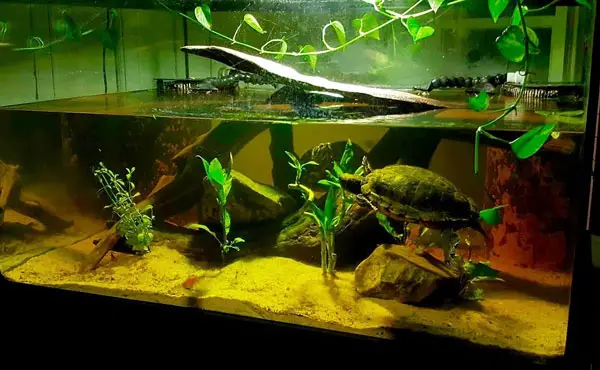
Feed your turtles outside the tank
We advise you to consider a designated feeding tub for your turtles rather than the main tank where they live.
This will help reduce the amount of waste that gets into the tank, keeping the water quality high and minimizing the chances of cloudiness.
It will also help cut down on the amount of maintenance you need to do to your tank.
Clean your filter regularly
Maintaining a regular filter maintenance schedule is another effective way to keep aquarium water quality top-notch and prevent cloudy turtle tank water from forming in the future.
When cleaning your filter, avoid washing the filter media that houses the good bacteria with tap water.
This can easily kill them and force the bacteria to restart the establishment process all over again, causing cloudiness in the process.
Get an aquarium vacuum
Does your turtle tank feature gravel? If yes, use a gravel vacuum to help you easily suck up the debris trapped underneath the rocks.
Gravels and pebbles can lead to waste accumulation in your turtle tank. Your tank filter is unable to pull this debris.
The waste is capable of breaking down and affecting your water quality, making your water turn cloudy. Plus, poor quality water can cause health issues for your pet.
This video gives you helpful tips on keeping your turtle water clean and healthy for your turtle friend.
How often should you do turtle tank water change?
We recommend doing a water change in your turtle tank once a week. You may think that changing water more frequently is a good way to prevent a cloudy situation.
But the truth is, doing this more often will increase your chances of dealing with a cloudy tank.
As mentioned earlier, turtles are quite messy as they eat as well as poop in the water, making it look cloudy. If you set up your tank correctly, it should feature a good pump and good bacteria that work together to help keep your tank clean.
Changing water too often can be a problem because you’ll be getting rid of the beneficial bacteria. And they’ll need to proliferate again before they can start consuming your pet turtle wastes again—increasing the likelihood of dealing with cloudy water for a couple of days.
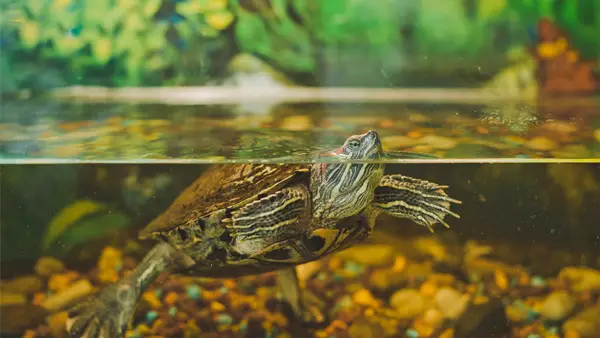
Also, when you first get your brand new tank, we advise letting the water stay for longer than a week. This will help give bacteria enough time to flourish.
When doing water changes, experts recommend you do a partial water change (i.e., only replace 30 to 50% of the water as opposed to full change) to avoid disrupting the already established bacteria.
Related questions (FAQs):
No. Cloudy water is not bad for your turtles and will not cause any harm, to them. It usually occurs due to bacterial bloom inside the water tank and fixes itself over time.
Cloudy water in your turtle tank can take anywhere from a few days to a week, or even more, to clear up. Don’t rush to change the water as this may not always work in helping clear your tank. Just be patient and let nature take its natural course!
Final Word
Cloudiness in your turtle tank mostly appears due to water imbalance and clears itself up with time. But it may also occur due to poor tank conditions and an uncleaned filter.
Cloudiness caused by bacteria is common in new tank setups and occurs as the beneficial bacteria establish themselves in the tank. It revolves on its own once the bacteria get established inside the tank and things become balanced.
You can prevent your tank from getting cloudy by cleaning your filter using the correct method and feeding your turtle outside.


